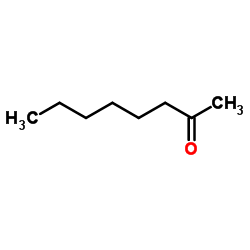2-Octanone

2-Octanone structure
|
Common Name | 2-Octanone | ||
|---|---|---|---|---|
| CAS Number | 111-13-7 | Molecular Weight | 128.212 | |
| Density | 0.8±0.1 g/cm3 | Boiling Point | 173.1±3.0 °C at 760 mmHg | |
| Molecular Formula | C8H16O | Melting Point | -16 °C | |
| MSDS | Chinese USA | Flash Point | 62.8±0.0 °C | |
| Symbol |


GHS02, GHS07 |
Signal Word | Warning | |
|
Novel organic solvents for electrochemistry at the liquid/liquid interface.
Analyst 140(6) , 1947-54, (2015) Two-phase voltammetry has been carried out using a reverse cell configuration, i.e. with the lower density organic solvent on the top of the aqueous solution in the cell, where the organic solvents contain either nitrile or ketone functional groups. The trans... |
|
|
Volatile Compounds from Grape Skin, Juice and Wine from Five Interspecific Hybrid Grape Cultivars Grown in Québec (Canada) for Wine Production.
Molecules 20 , 10980-1016, (2015) Developed from crosses between Vitis vinifera and North American Vitis species, interspecific hybrid grape varieties are becoming economically significant in northern areas, where they are now extensively grown for wine production. However, the varietal diffe... |
|
|
Comparison between solid phase microextraction (SPME) and hollow fiber liquid phase microextraction (HFLPME) for determination of extractables from post-consumer recycled PET into food simulants.
Talanta 127 , 59-67, (2014) Hollow fiber liquid phase microextraction (HFLPME) and solid phase microextraction (SPME) methods for pre-concentration of contaminants (toluene, benzophenone, tetracosane and chloroform) in food simulants were investigated. For HFLPME 1-heptanol, 2-octanone ... |
|
|
Characterization of Volatile Flavor Compounds in Chinese Rice Wine Fermented from Enzymatic Extruded Rice.
J. Food Sci. 80 , C1476-89, (2015) Enzymatic extrusion, instead of traditional steam cooking, to treat rice is an efficient and alternative pretreatment for Chinese rice wine fermentation. In order to determine the formation of volatiles in enzymatic extrusion-processed rice wine (EE), and to ... |
|
|
A novel carbonyl reductase with anti-Prelog stereospecificity from Acetobacter sp. CCTCC M209061: purification and characterization.
PLoS ONE 9(4) , e94543, (2014) A novel carbonyl reductase (AcCR) catalyzing the asymmetric reduction of ketones to enantiopure alcohols with anti-Prelog stereoselectivity was found in Acetobacter sp. CCTCC M209061 and enriched 27.5-fold with an overall yield of 0.4% by purification. The en... |
|
|
Analysis of volatile organic compounds liberated and metabolised by human umbilical vein endothelial cells (HUVEC) in vitro.
Cell Biochem. Biophys. 71(1) , 323-9, (2015) Gas chromatography with mass spectrometric detection combined with head-space needle trap extraction as the pre-concentration technique was applied to identify and quantify volatile organic compounds released or metabolised by human umbilical vein endothelial... |
|
|
Novel Methodology for Measuring Temperature-Dependent Henry's Constants of Flavor Molecules.
J. Agric. Food Chem. 63 , 6313-8, (2015) A new methodology is presented to measure water-air partition coefficients (Henry's constants) of volatiles, using APCI-MS. Significant advantages over other Henry's constant determination methods include the short measurement and sample preparation time and ... |
|
|
Purification and characterization of an anti-Prelog alcohol dehydrogenase from Oenococcus oeni that reduces 2-octanone to (R)-2-octanol.
Biotechnol. Lett. 32(4) , 533-7, (2010) An anti-Prelog alcohol dehydrogenase from Oenococcus oeni that reduces 2-octanone to (R)-2-octanol was purified by 26-fold to homogeneity. The enzyme had a homodimeric structure consisting of 49 kDa subunits, required NADPH, but not NADH, as a cofactor and wa... |
|
|
Evaluation of parallel milliliter-scale stirred-tank bioreactors for the study of biphasic whole-cell biocatalysis with ionic liquids.
J. Biotechnol. 157(1) , 253-7, (2012) As clear structure-activity relationships are still rare for ionic liquids, preliminary experiments are necessary for the process development of biphasic whole-cell processes involving these solvents. To reduce the time investment and the material costs, the ... |
|
|
Prolonged stimulus exposure reveals prolonged neurobehavioral response patterns.
J. Comp. Neurol. 518(10) , 1617-29, (2010) Although it has been shown repeatedly that minimum response times in sensory systems can be quite short, organisms more often continue to respond to sensory stimuli over considerably longer periods of time. The continuing response to sensory stimulation may b... |